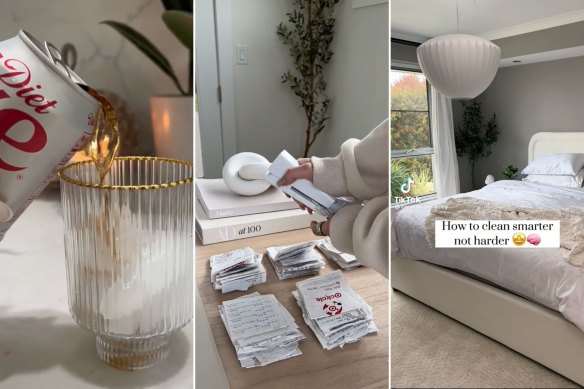Last week, I came across a TikTok of a user doing their taxes. As expected, it was a pretty boring video, and yet I couldn’t look away. The TikTok, uploaded by American influencer Kaeli Mae, quickly went viral, logging 4.2 million views (and counting) and nearly a million likes.
A muted, neutral palette is a signature of this genre of TikTok videos.Credit:TikTok: @kaelimaee; @carolina.mccauley; @alexismarieevans
The video opens with Mae making an iced coffee in a spotless kitchen, where seemingly everything is white. She moves into her home office (also all white) and pulls out a beige calculator, pastel pens, and notebooks from her immaculately organized drawer. She gathers her receipts and carefully records each transaction in a leather-bound journal.
All of Mae’s videos stick to this soft, muted palette, focusing on simple daily tasks like refilling her ice cube trays, packing her bag for work, or cleaning her car. In her pristine world of beige and pastels, even the simplest tasks take on a new dimension. Everything, including doing taxes, is designed to the max.
Content like this abounds on social media today, and it’s not all new. The past year has seen a surge in popularity for “day in my life videos,” where even the most mundane tasks are turned into content.
Professor Crystal Abidin, an expert in social media and influencer cultures at Curtin University, attributes this to the pandemic. With travel no longer a possibility, “content from all genres needed to spin to be at home.” Abidin says the lockdown saw “the expansion of the ability to create content at home, reaching the general population as zoom and work-at-home became mainstream.”
She says this democratization of content creation peaked when companies like Kmart and Target began announcing furniture to enhance your home office, zoom backdrops, and ring lights, all at affordable prices. “This mentality of having to put on your best face was a response to having to bring your camera into the house,” says Abidin.
Charging
This genre of content has roots deeper than the pandemic, dating back to the proliferation of lifestyle vlogging on YouTube that emerged in the 2010s, says Abidin. So what has changed, more than a decade later? Now, he says, virtually every minor step of the day has been embellished, from health and fitness to cleaning, and now, taxes, and prepared for public consumption. “The pandemic has almost completely wiped out the work/life balance. It has become normal to bring audiences into your home, whether through work or otherwise.”
Unlike other viral videos in this genre, the TikTok tax “is very mundane and more tedious,” he says. “All the other videos try to elevate the everyday experience, it doesn’t matter how small, and it used to be simpler,” she says. Think: simple tasks like making a cup of tea or loading the dishwasher.
Source: news.google.com
